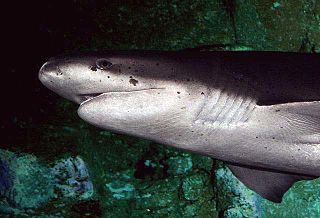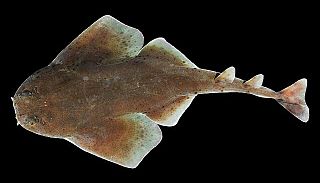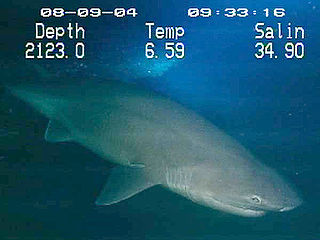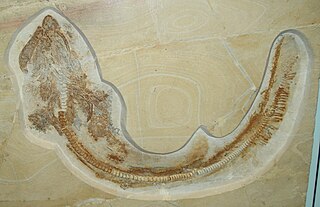
The Hexanchiformes are a primitive order of sharks, numbering just seven extant species in two families. Fossil sharks that were apparently very similar to modern sevengill species are known from Jurassic specimens.

The Lamniformes are an order of sharks commonly known as mackerel sharks. It includes some of the most familiar species of sharks, such as the great white as well as less familiar ones, such as the goblin shark and megamouth shark.

Squatiniformes is an order of sharks belonging to Squalomorphii. It contains only a single living genus Squatina, commonly known as angelsharks. The oldest genus of the order, Pseudorhina is known from the Late Jurassic of Europe. Three other genera, Cretasquatina, Cretascyllium and Parasquatina are known from Cretaceous fossils from North America and Europe, though the placement of Parasquatina in the order has been questioned. All living and extinct members of the order share a similar body morphology with a highly flattened body with enlarged pectoral and pelvic fins suggestive of a bottom-dwelling ambush predator ecology. Teeth have been assigned to the modern genus from the Late Jurassic onwards, but the actual genus assignment of many of these species is unclear. The earliest records that can be assigned with confidence to the modern genus are known from the Early Cretaceous (Aptian) of England.

Cow sharks are a shark family, the Hexanchidae, characterized by an additional pair or pairs of gill slits. Its 37 species are placed within the 10 genera: Gladioserratus, Heptranchias, Hexanchus, Notidanodon, Notorynchus, Pachyhexanchus, Paraheptranchias, Pseudonotidanus, Welcommia, and Weltonia.

Elasmobranchii is a subclass of Chondrichthyes or cartilaginous fish, including modern sharks, rays, skates, and sawfish. Members of this subclass are characterised by having five to seven pairs of gill clefts opening individually to the exterior, rigid dorsal fins and small placoid scales on the skin. The teeth are in several series; the upper jaw is not fused to the cranium, and the lower jaw is articulated with the upper. The details of this jaw anatomy vary between species, and help distinguish the different elasmobranch clades. The pelvic fins in males are modified to create claspers for the transfer of sperm. There is no swim bladder; instead, these fish maintain buoyancy with large livers rich in oil.

Hybodus is an extinct genus of hybodont that lived from the Middle Triassic to the Late Cretaceous periods. Species closely related to the type species Hybodus reticulatus lived during the Early Jurassic epoch. Numerous species have been assigned to Hybodus spanning a large period of time, and it is currently considered a wastebasket taxon that is 'broadly polyphyletic' and requires reexamination.

Hybodontiformes, commonly called hybodonts, are an extinct group of shark-like cartilaginous fish (chondrichthyans) which existed from the late Devonian to the Late Cretaceous. Hybodonts share a close common ancestry with modern sharks and rays (Neoselachii) as part of the clade Euselachii. They are distinguished from other chondrichthyans by their distinctive fin spines and cephalic spines present on the heads of males. An ecologically diverse group, they were abundant in marine and freshwater environments during the late Paleozoic and early Mesozoic, but were rare in open marine environments by the end of the Jurassic, having been largely replaced by modern sharks, though they were still common in freshwater and marginal marine habitats. They survived until the end of the Cretaceous, before going extinct.

Paraorthacodus is an extinct genus of shark. It a member of the family Paraorthacodontidae, which is either placed in Hexanchiformes or in Synechodontiformes. It is known from over a dozen named species spanning from the Early Jurassic to the Paleocene, or possibly Eocene. Almost all members of the genus are exclusively known from isolated teeth, with the exception of P. jurensis from the Late Jurassic-Early Cretaceous of Europe, which is known from full body fossils from the Late Jurassic of Germany, which suggest that juveniles had a robust body with a round head, while adults had large body sizes with a fusiform profile. There was only a single dorsal fin towards the back of the body without a fin spine. The dentition had teeth with a single large central cusp along with shorter lateral cusplets, which were designed for clutching. The teeth are distinguished from those of Synechodus by the lateral cusplets decreasing in size linearly away from the central cusp rather than exponentially as in Synechodus.

Meristodonoides is an extinct genus of hybodont. The type species is M. rajkovichi, which was originally a species in the genus Hybodus. The species, along with other Hybodus species such as H. butleri and H. montanensis, was reassigned to Meristodonoides by Charlie J. Underwood and Stephen L. Cumbaa in 2010. The species is primarily known from remains from the Cretaceous of North America, spanning from the Aptian/Albian to Maastrichtian, making it one of the last surviving hybodont genera, though records of the genus likely extend as far back as the Late Jurassic, based on an undescribed skeleton from the Tithonian of England, and fragmentary teeth from the Kimmeridgian of Poland, England and Switzerland. Other remains of the genus are known from the Coniacian of England, the Aptian-Albian of France, and the Campanian of European Russia. The morphology of the teeth suggests an adaptation to tearing prey. Fossils from the Western Interior Seaway suggest that it preferred nearshore marine environments, being absent from deeper-water areas, with it likely also being able to tolerate brackish and freshwater conditions.
Welcommia is an extinct genus of shark. It contains only three species :-
Crassodontidanus is an extinct genus of sharks and the sole member of the family Crassodontidanidae, in the order Hexanchiformes. It contains two extinct species.

Orthacodontidae is an extinct family of sharks. It is disputed as to whether it belongs to the modern shark order Hexanchiformes, or the extinct order Synechodontiformes. It contains two genera. Some other authors included it in Lamniformes.

Synechodontiformes is an extinct order of prehistoric shark-like cartilaginous fish, known from the Permian to the Paleogene. They are considered to be members of Neoselachii, the group that contains modern sharks and rays.

Paracestracion is an extinct genus of heterodontiform sharks from Early Jurassic to Early Cretaceous-aged rocks of England, France, Germany and Luxembourg. The genus was first described in 1911 by Ernst Hermann Friedrich von Koken in Karl Alfred von Zittel.

Synechodus is an extinct genus of shark belonging to the family Palaeospinacidae and order Synechodontiformes. It is known from 16 species primarily spanning from the Late Triassic to Paleocene. The dentition is multicusped and was used for grasping. Several species are known from skeletal remains, including the species Synechodus ungeri from the Late Jurassic of Germany, which shows that it was relatively short with large pectoral fins and a proportionally large head with a round snout. This species is suggested to have reached a body length of 30–40 centimetres (0.98–1.31 ft). Skeletal remains are also known of the species Synechodus dubrisiensis from the Cretaceous of Europe. A skeleton of an indeterminate species is also known from the Early Cretaceous (Albian) of France, with a body length of around 70 centimetres (2.3 ft). Synechodus is suggested to have had two dorsal fins that lacked fin spines, though the number of dorsal fins is unknown in Synechodus ungeri.
Eoptolamna is an extinct genus of mackerel sharks that lived during the Cretaceous. It contains two valid species, E. eccentrolopha and E. supracretacea, which have been found in Europe and North Africa.

Pseudorhina is an extinct genus of squatiniform shark closely related to modern angelsharks. Fossils are known from the Late Jurassic and Early Cretaceous of Europe.

Pseudoscapanorhynchidae is a family of extinct mackerel sharks that lived during the Cretaceous and potentially the Paleogene. It currently includes Cretodus, Eoptolamna, Leptostyrax, Protolamna, Pseudoscapanorhynchus, and possibly Lilamna.

Sphenodus is an extinct genus of shark. It is placed as a member of the extinct family Orthacodontidae, which is either considered to be a member of the extinct order Synechodontiformes, or the modern shark order Hexanchiformes. 29 species have been described, though some of these are likely synonyms, which span from the Early Jurassic (Sinemurian) to Paleocene (Danian). Most species are only known from isolated teeth, though the species Sphenodus macer and Sphenodus nitidus from the Late Jurassic of Germany are known from skeletons. These suggest that it was relatively large, with a body length of 2–3 metres (6.6–9.8 ft), with a fusiform body with a single dorsal fin placed posteriorly without a fin spine. The teeth of Sphenodus consist of a single long, narrow central cusp, with much smaller lateral cusplets. Species of Sphenodus are thought to have been actively swimming predators.















